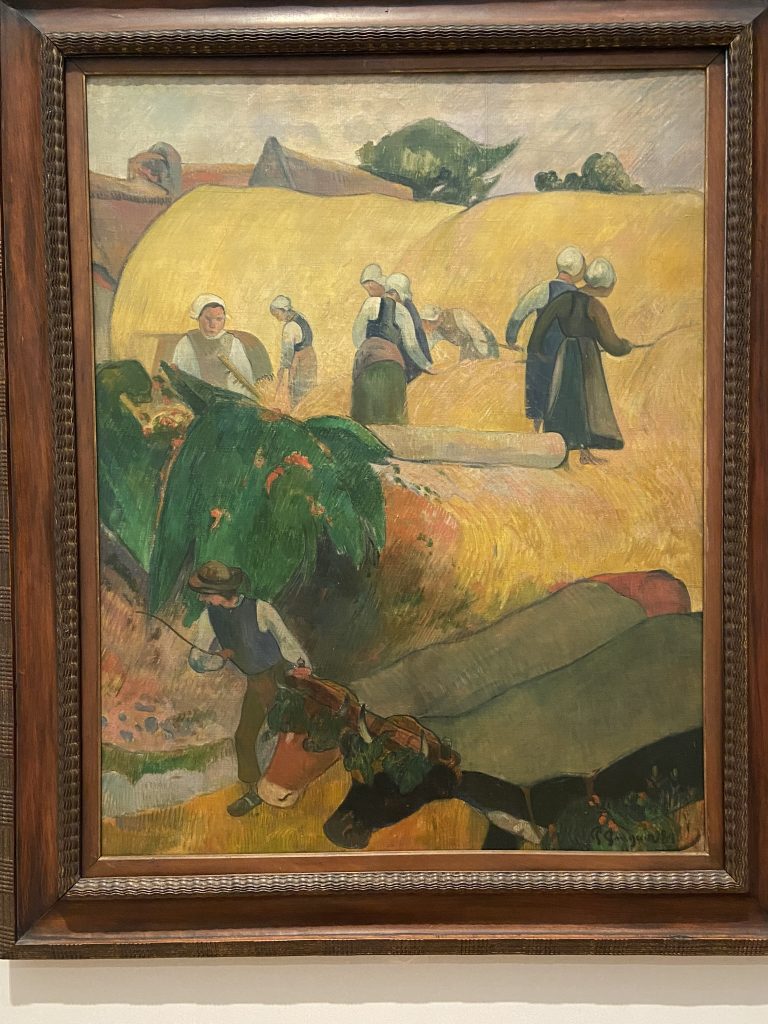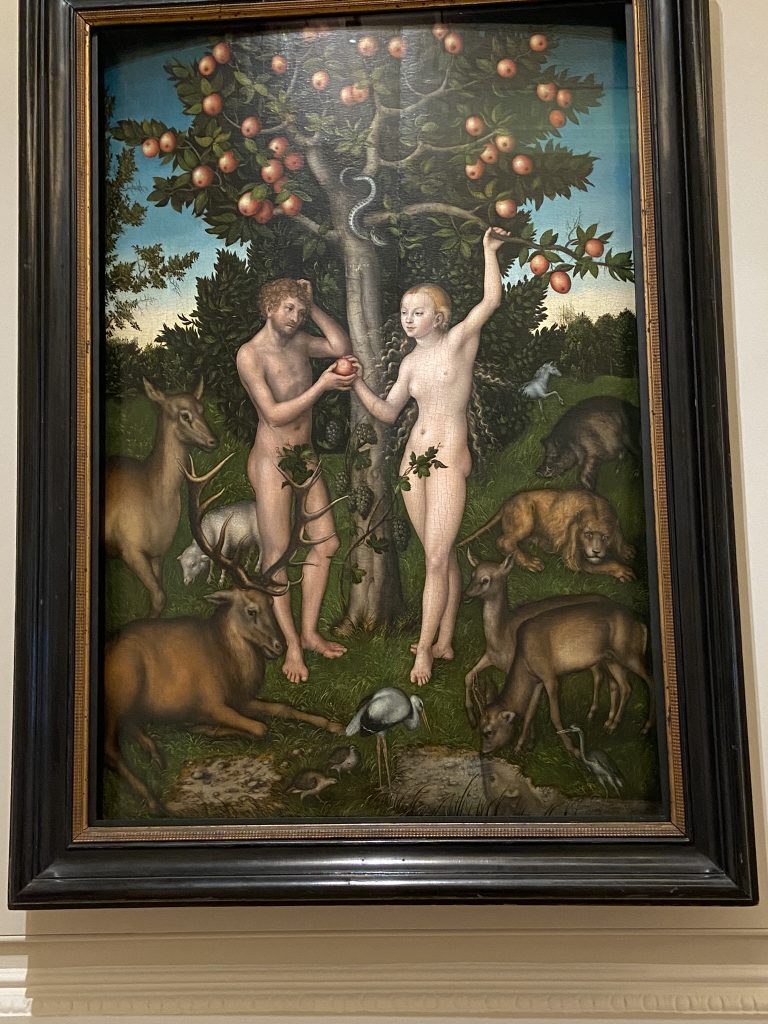Best of the Courtauld Gallery in London: A Treasure Trove for the Artsy Traveler
Artsy Traveler contains affiliate links for products and services I personally use and can happily recommend. As an Amazon Associate, I earn from qualifying purchases. Please read the Disclosure for more information. If you make a purchase through these links, at no additional cost to you, Artsy Traveler earns a small commission. Thank you!
I recently visited the Courtauld Gallery within hours of landing at Heathrow after flying to London from Vancouver. After three years away from Europe, I was itching to see great art, and the Courtauld Gallery turned out to be the perfect place to ease my way back into artsy traveling.
It’s small, it’s centrally located, and its collection is exquisite.
The highlights of the Courtauld Gallery are the truly impressive Impressionist collection and the medieval collection.

What is the Courtauld Gallery?
The Courtauld Gallery is part of the renowned Courtauld Institute of Art. This research-led higher education institution is the University of London’s largest community of art historians, conservators and curators. The gallery recently reopened after being closed for three years. The new and improved version is little short of spectacular.
Impressionist Collection at the Courtauld Gallery
Like the vast majority of visitors, I headed first to the top floor to view the Impressionist collection and the special exhibition of paintings by Edvard Munch (see my review of this exhibition). The room containing the Impressionist collection attracts the most visitors and can get a bit crowded.
I walked into the large room containing a delicious collection of Impressionists and immediately had to sit down to prevent myself from falling down and embarrassing myself. What I really wanted to do is laugh out loud and twirl myself past masterpiece after masterpiece, giddy with the beauty surrounding me.
When, finally, I collected myself, I began pacing slowly and reverently past gorgeous painting after gorgeous painting by all the biggies—Monet, Cézanne, Gauguin, Renoir, and on and on.
Here are just a few of the highlights of the Impressionist collection.
Tall Trees at the Jas de Bouffan by Paul Cézanne

Cézanne painted many views of the countryside surrounding Jas de Bouffan, a rural estate outside Aix-en-Provence owned by Cézanne’s father. Having visited the area, I can attest that Cézanne captures the shimmering quality of the light and the particularly vivid shades of green unique to Provence. My favorite Cézannes are his paintings of the Provence landscapes and this one is a keeper for sure!
Young Woman Powdering Herself by Georges Seurat

I’ve long been a fan of Georges Seurat who created the “pointillist” style of painting. He followed newly formulated optical theories by placing colors from opposite sides of the color wheel–orange and blue; pink and green–next to each other to create contrast. Seurat died at age 31 but he left behind some stunning works, this one being his only major portrait.
Self Portrait with Bandaged Ear by Vincent van Gogh

I couldn’t believe the Courtauld had this piece! It’s one of my favorite van Goghs. I love how he contrasts the various colors–blue hat, green coat, orange face–and also includes the image of one of the Japanese prints he collected. Van Gogh was heavily influenced by Japanese printmaking. He painted this piece in 1889, a week after leaving hospital following the famous incident when he cut off a portion of his left ear after a heated argument with Paul Gauguin. Even injured, van Gogh was determined to keep painting.
The Haystacks by Paul Gauguin

And speaking of Gauguin, I was thrilled to see this piece which he painted while he was living in Brittany. Gregg Simpson (husband and painter) is currently working on the Pont Aven Suite, a series inspired by Gauguin’s Brittany paintings, so Gauguin has been a regular topic of a conversation in our house. I love how Gauguin simplifies and flattens forms and colors. This piece has so much movement–the women raking hay above and the man driving the oxen below.
Enjoying this post? Subscribe to Artsy Traveler to Receive Valuable Travel Tips and Your FREE Guide: 25 Must-Do Artsy Traveler Experiences in Europe for 2025

A Bar at the Folies-Bergère by Edouard Manet

Fabulous as all the pieces in the Impressionist collection are, the best of all is my old friend A Bar at the Folies-Bergères by Manet. What a painting!
The young barmaid (the model’s name was Suzon) looks out at the viewer, her expression both bored and vulnerable at the same time. According to the descriptive text next to the piece, “Manet created a complex and absorbing compostion that is considered one of the iconic paintings of modern life.” That is certainly true!
Suzon is every person in the world working in a dead-end job they hate and yet obliged to pretend they enjoy for the sake of the customers.
Medieval Collection at the Courtauld Gallery
After thoroughly exploring the top floor, I began my descent to the other two floors to explore the rest of the Courtauld Gallery’s collection. I was in for a treat as it turned out.
One of my favorite eras for painting is the middle ages, particularly the first half of the 14th century when artists were not worried about perspective and realism. I love the use of gold, the pastel shades of the egg tempera paint the artists used, and the lego-like way in which they depicted medieval buildings.
Well, the Courtauld delivered! To my delight, it houses a lovely medieval collection that includes such notables as Lorenzetti and Duccio—two hometown boys from Siena, my fave Italian city (and one of the settings for The Towers of Tuscany).
As is often the case in art museums, the medieval rooms were pretty much empty so I drifted from painting to painting and admired to my heart’s content.
A highlight is a series of small panels painted by Fra Angelico (1417-1455) that depicts six female saints. Each face is incredibly expressive and compelling. I wonder who Fra Angelico used as models.






Other Highlights of the Courtauld Gallery Collection
After thoroughly exploring and enjoying the large collection of medieval art, I toured the rest of the collection. There’s a fair number of works from the 16th to the 19th centuries, including works by Rembrandt, Gainsborough, Reynolds, and Rubens.
A big selling point of the Courtauld is its compact size and that each piece in the colleciton is stellar. I don’t think I’ve ever visited an art museum where the quality of all the pieces is so uniformly high.
After my visit, I got chatting with the young man in the gift shop. He enthusiastically agreed that the Courtauld’s collection is first-rate and also kindly listened to me rattle on about how I first visited the Courtauld with my mom back in 1970 (likely a good forty years befor he was born!)
Here are two more of my favorites at the Courtauld Gallery.


Courtauld Gallery Practical Information
The Courtauld Gallery is open Monday to Sunday from 10:00 to 18:00. Book your ticket in advance on the website to avoid line-ups and also to make sure you get in! Check the website also for special exhibitions. The Munch exhibition I saw was definitely worth the extra price.
Where to Stay in London
Stay as close to the center of London as you can afford. You’ll be able to walk a lot more places that you’ll want to see and you’ll feel like you’re where the action is!
Here are three recommendations:
- Park Plaza Victoria London Hotel located right across the street from Victoria Station is a good deal for a modern, four-star hotel in the heart of London.
- Wilde ApartHotel just off the Strand is an excellent choice and couldn’t be more central for the West End Theaters. It’s also within easy walking distance of the Courtauld Gallery.
- The ParkCity in Kensington is a bit farther off the beaten track but very close to some of my favorite museums, including the Victoria & Albert.
London Tours & Tickets
Here are some options for touring London and buying tickets for interesting museums such as the Design Museum and other attractions.
London Walking Tours
GuruWalk lists pay-what-you-please walking tours that connect tourists with tour guides all around the world. Check out their tours of London!
Conclusion
As my first visit to a world-class art museum in three years, the Courtauld was the perfect choice. It gently eased me back into artsy traveling, doling out artsy hits like small bites of gourmet chocolates—each one more flavorful than the last and yet all equally fabulous.
Have you visited the Courtauld? Which piece was your favorite? Share your experience in the Comments section below.
Here are some more posts about favorite art museums in Europe:

[…] In this post, I cover a few highlights. For a more in depth post about the Courthauld with plenty of examples of works you’ll see there, check out my post Courtauld Gallery in London: A Treasure Trove for the Artsy Traveler. […]
[…] Courtauld Gallery in London: A Treasure Trove for the Artsy Traveler […]
[…] Courtauld Gallery in London: A Treasure Trove for the Artsy Traveler […]